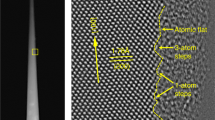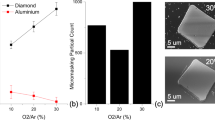Abstract
WE describe here recent developments which permit the selection of diamonds very free from strain by purely optical inspection. Figure 1a shows the edge of a diamond slab which chipped while being polished, and Fig. 1b the same slab viewed between crossed polars1. The birefringent pattern indicates a region of strain centred near the crack, and a dark area where the chip has come away relieving the strain. This type of strain birefringence is, of course, well known, and by carefully selecting diamonds on the basis of their birefringence it is possible to obtain stones for tools with a superior resistance to chipping. For example, the six similar tools in a wear experiment described by Casey and Wilks2 were chosen in this way, and wore steadily without any chipping. Bell, Wilks and Wilks3 have described how the resistance of a diamond to cracking and chipping may be estimated by measuring the load on a small diamond sphere required to produce a ring crack on a flat diamond surface. In these experiments, measurements on a diamond slab chosen to be free of birefringence gave consistent values of the fracture load which were about twice as high as those on another slab which showed marked birefringence.
This is a preview of subscription content, access via your institution
Access options
Subscribe to this journal
Receive 51 print issues and online access
$199.00 per year
only $3.90 per issue
Buy this article
- Purchase on Springer Link
- Instant access to full article PDF
Prices may be subject to local taxes which are calculated during checkout
Similar content being viewed by others
References
Wilks, J., Ind. Diam. Rev., 382 (1973).
Casey, M., and Wilks, J., Diam. Res. 11 (1972); Int. J. Mach. Tool Des. Res., 16, 13 (1976).
Bell, J. G., Wilks, E. M., and Wilks, J., Ind. Diam. Rev., 135 (1975).
Frank, F. C., Puttick, K. E., and Wilks, E. M., Phil. Mag., 3, 1262 (1958).
Frank, F. C., and Lang, A. R., Phil. Mag., 4, 383 (1959).
Wilks, E. M., and Wilks, J., Ind. Diam. Rev., 238 (1971).
Wilks, E. M., Diam. Res., 7 (1969).
Jackson, A., Nucl. Instrumen. Meth., 129, 73 (1975).
Author information
Authors and Affiliations
Rights and permissions
About this article
Cite this article
WILKS, E. Optical methods to select diamonds of very high lattice perfection. Nature 262, 570–571 (1976). https://doi.org/10.1038/262570a0
Received:
Accepted:
Issue Date:
DOI: https://doi.org/10.1038/262570a0
This article is cited by
-
An electrostatic technique for revealing internal structure in diamonds
Journal of Materials Science (1979)
Comments
By submitting a comment you agree to abide by our Terms and Community Guidelines. If you find something abusive or that does not comply with our terms or guidelines please flag it as inappropriate.



